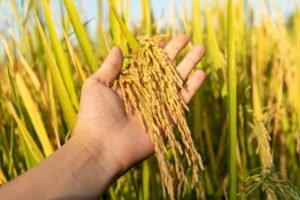Cultivation Guide Elephant Foot Yam For Beginners
In today’s time the cultivation of jimikand / suran / jimikand / Ol has started being done commercially. Some time ago jimikand was done in the remaining places in the villages. But in view of its medicinal properties its commercial cultivation has started.
Details for the drip irrigation system for beginners.
In English it is also called Elephant Foot Yam or Amorphophallus. It is a vegetable of Indian origin. It is a herbaceous plant whose tubers sit at the bottom. Cattle do not eat its leaves so there is no fear of grazing by cattle. Due to the tubers sitting in the ground below the fear of theft is also less. Apart from vegetable it is used as medicine. It is very useful in piles and removes constipation. It is also useful in stomach pain. Apart from vegetables it is also used in pickles and fillings.

Some of the major benefits of jimikand:
- It helps in working the blood pressure.
- Zimikand acts as a powerful anti-oxidant which helps in slowing down the aging process.
- It helps in curing abdominal pain, diarrhea and gas.
- Its use helps in preventing muscle spasms.
- It helps in cleaning the liver.
- Its use is beneficial in the disease of piles.
- It helps in reducing cholesterol.
- It is very beneficial for diabetic patient.
- Due to its medicinal properties, it works in the treatment of cancer.
- Jimikand is also very beneficial in working out weight.
Economical Aspect Suran is fast becoming popular in everywhere as a commercial vegetable. Due to the sharp cuts in the mouth its dishes were prepared by mixing it with sour ingredients. But nowadays its utility as a cash crop has increased a lot with the “Gajendra” variety that is often not harvested in the mouth and gives more yield.
The yield potential of this variety is 20 to 40 tonnes per acre. If 15/- per kg i.e. 5000/- (five thousand) per ton is also sold then the average income will be one lakh. If the expenditure is deducted in this, then the income of of Rs 75 thousand per acre can be done.. In this way farmers can get good income by cultivating it. The second variety of jimikand is “Santragachi” which is popular in West Bengal. Sripadma is also an improved variety of tartless jimikand extracted from Central Tuber Root Research Institute, Trivandrum.

Climate and Soil – Jimikand requires a warm climate. It is beneficial to have humidity in the beginning at the time of growth. The temperature is favorable from 25 to 35 degrees. Dry weather is beneficial at the time of sitting height. It is good to have 1000-1500 mm of rainfall.
Moringa Cultivation Guide For The Beginners.
Soil Conditions: -loam soil with good drainage should be selected for yam. There should be no stagnation of water in the ground at all. There will be no problem of water stagnation due to a little swampy ground. The field should be made level by plowing two or three times.
Advanced Vegetable Farming System
Time of planting – Jimikand is a crop of 6-7 months, so it should get time to grow. If irrigation facility is available then it should be planted in April-May. If there is no water facility it should be planted as soon as the rain starts.
Improved Varieties – The “Gajendra” variety is suitable for commercial cultivation, it is a variety from South India and is also known as Madrasi Ol’ in the market. This variety does not have a sharp cutting chemical, so it does not bite the mouth. The earlier variety had to be mixed with pickles while preparing the dishes to remove the pungency. This variety is gaining popularity due to the absence of mouth-erosing chemicals. The “Santragachi” variety of West Bengal is also suitable for commercial cultivation. Seed rate will be based on the seed size.
Protected Farming Guide For The Beginners.
If we plant half kg weight, then fifty quintal per hectare (twenty quintal per acre) seed height will be taken. Time of planting The jimikand is a crop of 6-7 months, so it should get time to grow. If irrigation facility is available then it should be planted in April-May.
If there is no water facility, it should be planted as soon as the rain starts. Seed treatment Mixing Macozeb (0.21%) and Monocrotophos (0.5%) in a thick solution of cow dung should be done by dipping the cut pieces in it. After removing from the dung solution, the tubers should be turned over and planted after drying for 4-6 hours.
Method of planting

Digging the pit In this method, the pit is dug at the prescribed distance. If there is a height of one kilo, then the distance from the pit is 90-100 cm and the size of the pit is 60 cm. x 60 cm x 45 cm i.e. the roundness of the pit is 60/cm. and depth is 45 cm. Keeps. If the seed height is half a kilo, then the size of the pit is 40 cm. x 40 cm x 40 cm and distance 50 cm. keep. While digging the pit, keep the upper 15-20 cm, the soil on one side and the lower soil on the other side. The soil of the pit and pit should be exposed to sunlight for 10-15 days.
Method of Sowing – In Gajendra variety, the number of daughter tubers is negligible. So the big height is cut and planted. Take a piece of height from half a kilo to one kilo and cut it in such a way that the upper part of each piece must be in demand, it is necessary to have a part of the top bud in the seed rhizome. Dip the cut tubers in a thick solution of cow dung and dry them in the shade. If the seed rhizome is treated by dipping it in Trichoderma (four grams per liter) solution, it gives very good results.
Best farming methods for tomato.
Seed height can also be prepared separately, for this cut pieces of 100 grams in which the top bud is part, cut these pieces by 30 cm. m. x 30 cm Plant it at a distance of six to eight months, the height of the seed will be ready, which weighs about 500 grams.

These seed buds do not have to be cut while planting which reduces the chances of the plants getting diseased. Some varieties of jimikand have small daughter centers of 25-35 grams along with the main tuber, they are 15-25 cm in size according to their size. At a distance of planting in May. The height obtained from this is planted again at a greater distance, in this way, after two to three cropping periods, the height (6-8) kg of large size.
Precautions – Transplanting seed tubers 15-20 cm apart at the time of planting. Keep in mind that after transplanting the top bud facing upwards. Cover the tree with a dry wall this will retain moisture the temperature will be favorable for germination weeds will also be less.
Irrigation – Provide light irrigation immediately after transplanting. Irrigation will not be required for farming. After 60-75 days of transplanting, remove any weeds and apply soil. Second weeding – weeding is done after the first weeding – weeding. At this time, hoeing should be done at a low depth and also add soil as needed, it should be kept in mind that during the rainy season, there is proper moisture during the development of the tuber. One irrigation may be required in November after the end of the rainy season. Light irrigation is required even before digging.
Latest updates on Organic Farming of Vegetables.
Diseases and Contrjimikand– When the plants are 2.5 to 3.5 month old with the arrival of rain the disease bears scleracium in the hail. In this disease water-cooled spots appear on the stem near the root and the plant turns yellow shrinks and breaks near the root. To control more disease jimikand the area should be changed and the tuber should be planted after seed treatment.
Collar rot, leaf blight disease and mosaic disease mainly occur in jimikand. For its control, transplanting mosaic free tubers should be covered with paddy straw after transplanting and after 60 to 90 days after transplanting, 2-25 grams of Macozeb and 1.5 ml of Monocrotophos drug should be dissolved in per liter of water and sprayed.

You should know how long will it be take to mature. Basically It takes 7-9 months depending on the variety to dig and harvest. Maturity is recognized by yellowing of leaves drying and falling of leaves. If the market price is good then digging can be done even before full maturity. The yield is about 5-7 times that of seed tubers i.e 1 kg seed tuber will yield an average of 5-7 kg tubers, while 10-12 kg height can also be obtained from a good crop. The average yield is 20-40 tons per acre (50-100 tons per hectare). While digging, take care not to injure or cut the tuber. If the tuber is cut or internally injured there is a risk of rotting in storage. Such tubers should be sent to the market for early marketing.




